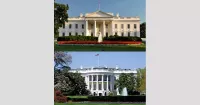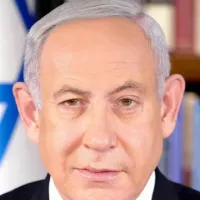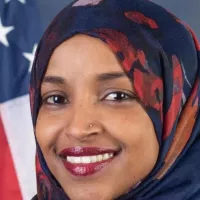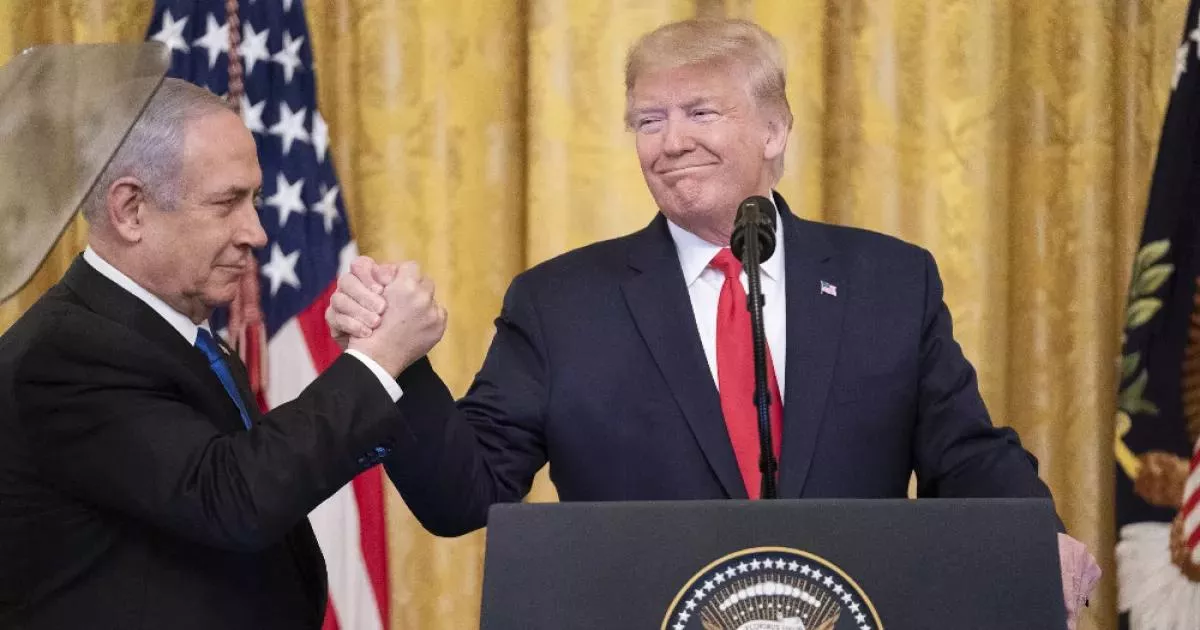The Trump peace plan, officially "Peace to Prosperity: A Vision to Improve the Lives of the Palestinian and Israeli People", aimed to resolve the Israeli-Palestinian conflict. Unveiled by President Trump and Israeli PM Netanyahu on January 28, 2020, the plan was delayed for two years and faced prior rejection from the Palestinians, who were absent from the unveiling.
1917: Balfour Declaration
In 1917, the British government issued the Balfour Declaration, announcing support for a "national home for the Jewish people" in Palestine.
1947: UN Partition Plan
In 1947, the United Nations adopted a Partition Plan for Palestine, allotting 56% of the land to the Jewish population, which comprised around 33% of the inhabitants.
1948: Jewish Exodus from Arab World
Following Israel's founding in 1948, a significant exodus of Jews from Arab countries occurred, influenced by various factors and impacting demographics and international relations.
1949: End of the 1947-1949 Palestine War
By the end of the 1947–1949 Palestine war in 1949, Israel controlled 78% of Mandatory Palestine.
1967: Trump Peace Plan Land Swaps
The Trump peace plan, revealed in later years, proposed land swaps related to the pre-1967 territories, aiming to address territorial disputes arising from the 1967 war.
1967: Trump Plan Addresses Refugees from 1967 War
The Trump plan also aimed to address the situation of Palestinian refugees displaced by the 1967 war, proposing solutions that sparked debates and discussions.
1967: UN Uses "Occupied Palestinian Territory"
The United Nations uses the term "occupied Palestinian territory" to refer to the area occupied by Israel since 1967.
1974: UN Resolution for Two-State Solution
A 1974 UN resolution called for a two-state solution to the Israeli-Palestinian conflict, with Israel and Palestine existing side-by-side.
1979: Publication of the Drobles Plan for Jewish Settlement
The Drobles Plan, published in 1979, aimed to expand Jewish settlements in Palestinian territories and prevent the establishment of a Palestinian state.
1983: Similarities Between Trump Plan, Drobles Plan, and Allon Plan
Analysis in 1983 revealed striking similarities between the Trump peace plan, the Drobles Plan from 1979, and the earlier Allon Plan. All three plans shared the goal of expanding Jewish settlements and limiting the possibility of a Palestinian state.
1991: Establishment of Har Homa Settlement
The establishment of Har Homa in 1991 marked a significant development in East Jerusalem, serving as a precedent for later settlement activities, including those proposed in the Trump plan.
1993: Oslo Accords Signed
The Oslo Accords, signed in 1993, granted Palestinians limited autonomy in parts of the West Bank.
1995: US Law Regarding Jerusalem
Trump's recognition of Jerusalem as Israel's capital followed a 1995 US law.
2000: Camp David Summit Failure and Second Intifada
Negotiations between Israelis and Palestinians continued until the Camp David Summit's failure in 2000, followed by the Second Intifada.
2012: Palestine Granted UN Non-member Observer State Status
Palestine was recognized as a state by 138 UN members and granted UN non-member observer status in 2012.
2015: Nickolay Mladenov Becomes UN Special Coordinator for Middle East Peace Process
Nickolay Mladenov became the United Nations Special Coordinator for the Middle East Peace Process in 2015.
2015: Trump Plan and the Status Quo of Haram al-Sharif
The Trump plan, while aiming to maintain the status quo at the Haram al Sharif/Temple Mount, proposed changes like allowing non-Muslim prayer, contrasting Netanyahu's 2015 reaffirmation of the existing status quo.
May 22, 2017: Netanyahu Shows Trump a Doctored Video of Mahmoud Abbas
On May 22, 2017, Benjamin Netanyahu, in an effort to influence Trump's stance on the Israeli-Palestinian conflict, showed him a fabricated video. This video was edited to falsely portray Palestinian President Mahmoud Abbas as inciting violence against children.
November 2017: Development of Trump Peace Plan Begins
Development of the Trump peace plan, led by Jared Kushner, began in November 2017.
December 2017: Trump Recognizes Jerusalem as Israel's Capital
In December 2017, Trump recognized Jerusalem as the capital of Israel, a move that was condemned by Arab countries and led to the Palestinians breaking off contact with the Trump administration.
2017: Netanyahu's Influence on Trump's Perception of Peace Prospects
Throughout 2017, Benjamin Netanyahu worked to convince Trump that Palestinian hostility posed the primary obstacle to peace. He drew parallels with Trump's experiences, suggesting Palestinians desired a border near Tel Aviv, similar to the proximity of the George Washington Bridge to Trump Tower.
February 2019: Kushner and Berkowitz Unveiled Peace Plan in Middle East Tour
In February 2019, Jared Kushner and Avi Berkowitz embarked on a tour of the Middle East to present a peace plan. They visited Oman, Bahrain, Qatar, the United Arab Emirates, Turkey, and Saudi Arabia.
March 2019: Trump Recognizes Golan Heights as Part of Israel
On March 2019, President Trump made a significant move by recognizing the Golan Heights as part of Israeli territory. This decision was a key part of the Trump peace plan.
April 2019: Greenblatt Clarifies Trump Peace Plan Does Not Include Confederation or Land Transfer
In April 2019, Jason Greenblatt, a key figure in the Trump administration's peace efforts, clarified that the peace plan did not propose a confederation model or a transfer of land from Egypt's Sinai Peninsula to the Palestinians.
April 2019: Third Israeli Election in a Year
Israel held its third election in the span of a year in April 2019, highlighting the intense political climate and the challenges in forming a stable government.
June 2019: Greenblatt Highlights Core Issues Addressed in Trump Plan
In June 2019, Greenblatt stated that the Trump peace plan aimed to address all core issues of the Israeli-Palestinian conflict. This included finding a resolution to the refugee issue and addressing Israel's security concerns.
June 2019: "Peace to Prosperity" Conference in Manama, Bahrain
In June 2019, a conference titled "Peace to Prosperity" was held in Manama, Bahrain. The event, focused on the economic aspects of the Trump peace plan, faced a boycott from Palestinian leadership and drew criticism from various experts.
June 2019: Trump Administration Releases Economic Portion of Peace Plan
In June 2019, the Trump administration released "Peace to Prosperity," the economic portion of the plan.
June 2019: Release of the Economic Portion of the Trump Peace Plan
The Trump administration released the economic portion of its peace plan on June 2019. This portion, composed of two extensive documents filled with financial data and projections, was later presented by Kushner at a workshop in Manama, Bahrain.
September 2019: Netanyahu's Pledge to Annex Part of the West Bank
In September 2019, Benjamin Netanyahu made a significant campaign promise: to annex a portion of the West Bank bordering Jordan. This pledge, contingent on his re-election, aimed to solidify Israeli control over the Jordan Valley and the northern Dead Sea region.
September 2019: Finalization of the "Political Plan" and Greenblatt's Resignation
In September 2019, Jared Kushner and Jason Greenblatt finished drafting the "political plan," which was kept confidential and only shared with a select few. Greenblatt resigned this same month, reportedly due to his belief that the plan lacked viability.
November 2019: US Declares Jewish Settlements in West Bank Consistent with International Law
In November 2019, the United States made another significant policy change by stating that Jewish settlements in the West Bank were not in violation of international law. This move further solidified the Trump administration's alignment with the Israeli position on settlements.
November 2019: United States Reverses Stance on Jewish Settlements
In a significant policy shift in November 2019, the United States abandoned its long-held position that Jewish settlements in the West Bank were inconsistent with international law.
2019: Experts Analyze US Policy Shift and Economic Peace Approach
In 2019, experts and analysts in the Middle East observed what they perceived as a significant shift in US policy towards the Israeli-Palestinian conflict. Some viewed it as a paradigm shift, while others argued that the economic-focused approach had been tried before without success.
January 2020: Netanyahu's Annexation Plans and US Response
In January 2020, Israeli Prime Minister Netanyahu announced his intention to annex 30% of the West Bank. However, the US administration shifted its position, calling for a joint committee to discuss the annexation and suggesting that it should align with the Trump peace plan's map.
January 2020: Palestinian Rejection and Protests
In January 2020, Palestinian President Mahmoud Abbas rejected the Trump peace plan, stating that Jerusalem was not for sale. Hamas also rejected the deal. Thousands of Palestinians protested in Gaza in a "day of rage."
January 2020: Trump Peace Plan Unveiled
In January 2020, President Donald Trump officially unveiled the "Peace to Prosperity" plan in a White House press conference with Israeli Prime Minister Benjamin Netanyahu. The Palestinians were not invited to this meeting.
January 2020: Unveiling of the Political Portion of the Plan
The Trump administration unveiled the political component of its peace plan in January 2020. This release coincided with the Trump impeachment trial and a period of political instability in Israel.
January 2020: Political Portion of Peace Plan Released
The political portion of the Trump peace plan was released in late January 2020.
February 2020: Mixed Signals and Reactions to Annexation Plans
February 2020 saw heightened tensions and mixed signals regarding the annexation. Settler leader David Elhayani accused Kushner of backtracking on annexation promises. US Ambassador Friedman warned that unilateral annexation would jeopardize the peace plan and US recognition. Despite this, Netanyahu announced the preparation of annexation maps, prompting Friedman to reiterate the need for a joint committee process. The committee, comprising US and Israeli officials, was announced without a set deadline.
February 2020: Netanyahu Postpones Annexation Vote
In February 2020, Netanyahu's cabinet canceled a vote on the West Bank annexation after receiving mixed signals from the United States.
February 2020: Palestinian Authority Cuts Ties and Criticism of Negotiations
In February 2020, the Palestinian Authority declared it was cutting ties with the US and Israel, including security cooperation, although this never happened. Lead Palestinian negotiator Saeb Erekat criticized the negotiation process, describing it as "dictation, arrogance, and blackmail."
February 2020: Trump Plan Designates Atarot for Israeli Settlement
In February 2020, the Trump plan announced the allocation of land in Atarot for a new Israeli settlement, contradicting its earlier proposal for a Palestinian tourist zone and raising concerns about land ownership.
February 2020: Pope Francis Expresses Concerns Over Trump Plan
On February 23, 2020, Pope Francis, addressing bishops, expressed concerns over the potential for inequitable solutions in the Israeli-Palestinian conflict, highlighting the risks of the Trump plan leading to further crises.
February 2020: Organisation of Islamic Cooperation Rejects Trump Plan
On February 3, 2020, the Organisation of Islamic Cooperation formally rejected the Trump plan, urging member states to refrain from supporting or cooperating with its implementation.
February 2020: Trump Plan Proposes Relocation of Arab Border Towns
On February 3, 2020, the Trump plan suggested relocating 11 Arab border towns, impacting Israel's Arab minority and raising concerns about citizenship and land ties.
March 2020: Possibility of a Fourth Israeli Election
By March 2020, the prospect of a fourth Israeli election loomed, further underscoring the deep political divisions and instability within the country.
May 2020: International Condemnation and EU Protest
On May 18, 2020, the EU issued a statement expressing "grave concern" over the new Israeli government's plan to annex parts of the occupied Palestinian territories. They urged Israel to refrain from any unilateral action, stating it would violate international law.
May 2020: UN Calls for Abandonment of Annexation Plans
On May 20, 2020, during a UN Security Council meeting, UN Middle East envoy Nickolay Mladenov urged Israel to abandon its annexation plans. He called the plan a "serious violation of international law" and warned it would hinder negotiations.
June 2020: UN Secretary-General Condemns Annexation Plans
On June 24, 2020, UN Secretary-General António Guterres urged Israel to abandon its annexation plans, calling it a "watershed moment" and a "most serious violation of international law." He warned of severe consequences for the two-state solution and negotiations.
June 2020: Palestinian Counter-Proposal
On June 9, 2020, Palestinian Prime Minister Mohammed Shtayyeh announced a counter-proposal to the Quartet. The proposal called for a "sovereign, independent, and demilitarized Palestinian state" with minor border adjustments and land swaps.
June 29, 2020: Gantz Objects to Annexation Deadline
Netanyahu's coalition partner, Benny Gantz, objected to the July 1, 2020 deadline for starting the West Bank annexation, prioritizing the COVID-19 pandemic. Gantz's objection cast doubt on the timeline.
July 1, 2020: US Confirms Delay in Annexation
On June 29, 2020, US sources confirmed that the West Bank annexation would not begin on the planned July 1 deadline.
2020: Reactions and Conditions of Trump Peace Plan
In 2020, the Trump peace plan was met with mixed reactions. Congressional Democrats denounced it, and its proposed benefits to the Palestinians were contingent upon conditions including demilitarization and abandoning legal action against Israel.
August 2022: Letter Obtained by The Jerusalem Post
In August 2022, The Jerusalem Post obtained a letter from January 26 of that year, revealing that the United States had offered to recognize Israeli sovereignty in parts of the West Bank in exchange for Israel's implementation of the Trump peace plan and adoption of territorial plans consistent with the plan's Conceptual Map.
Mentioned in this timeline

Donald John Trump is an American politician media personality and...

Pope Francis served as the head of the Catholic Church...

The White House located at Pennsylvania Avenue NW in Washington...

Benjamin Bibi Netanyahu is a prominent Israeli politician and diplomat...
Saudi Arabia officially the Kingdom of Saudi Arabia KSA is...
Qatar is a country located on the Qatar Peninsula in...
Trending

9 days ago Tyler Adams aims for historic World Cup run; Pochettino warns USMNT against complacency.

21 days ago Huntington Beach Flooded After Storm; Southern California Experiences Wettest November on Record

2 months ago Travis Scott's Epic Johannesburg Performance: Fans Brave Weather for Unforgettable Show

6 months ago Immanuel Iheanacho, a five-star OT, narrows down top schools, including LSU Tigers.
17 days ago Dylan Raiola Transfer Rumors Surface; Brother Decommits from Nebraska, Future Uncertain

25 days ago Bitwise Launches XRP ETF Amidst Market Activity; XRP Staking Explored.
Popular

Candace Owens is an American conservative political commentator and author...

Ilhan Omar is an American politician currently serving as the...

XXXTentacion born Jahseh Dwayne Ricardo Onfroy was a controversial yet...

Frederick Christ Trump Sr - was an American real estate...

Oprah Winfrey an American talk show host television producer actress...

Cristiano Ronaldo often nicknamed CR is a Portuguese professional footballer...
